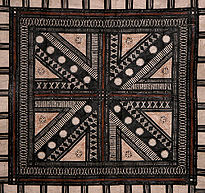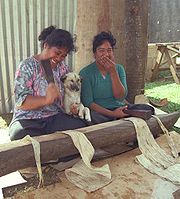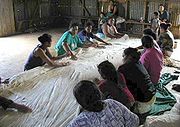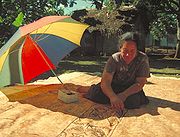
Tapa cloth
Encyclopedia

Pacific Ocean
The Pacific Ocean is the largest of the Earth's oceanic divisions. It extends from the Arctic in the north to the Southern Ocean in the south, bounded by Asia and Australia in the west, and the Americas in the east.At 165.2 million square kilometres in area, this largest division of the World...
, primarily in Tonga
Tonga
Tonga, officially the Kingdom of Tonga , is a state and an archipelago in the South Pacific Ocean, comprising 176 islands scattered over of ocean in the South Pacific...
, Samoa
Samoa
Samoa , officially the Independent State of Samoa, formerly known as Western Samoa is a country encompassing the western part of the Samoan Islands in the South Pacific Ocean. It became independent from New Zealand in 1962. The two main islands of Samoa are Upolu and one of the biggest islands in...
and Fiji
Fiji
Fiji , officially the Republic of Fiji , is an island nation in Melanesia in the South Pacific Ocean about northeast of New Zealand's North Island...
, but as far afield as Niue
Niue
Niue , is an island country in the South Pacific Ocean. It is commonly known as the "Rock of Polynesia", and inhabitants of the island call it "the Rock" for short. Niue is northeast of New Zealand in a triangle between Tonga to the southwest, the Samoas to the northwest, and the Cook Islands to...
, Cook Islands
Cook Islands
The Cook Islands is a self-governing parliamentary democracy in the South Pacific Ocean in free association with New Zealand...
, Futuna, Solomon Islands
Solomon Islands
Solomon Islands is a sovereign state in Oceania, east of Papua New Guinea, consisting of nearly one thousand islands. It covers a land mass of . The capital, Honiara, is located on the island of Guadalcanal...
, Java, New Zealand
New Zealand
New Zealand is an island country in the south-western Pacific Ocean comprising two main landmasses and numerous smaller islands. The country is situated some east of Australia across the Tasman Sea, and roughly south of the Pacific island nations of New Caledonia, Fiji, and Tonga...
, Vanuatu
Vanuatu
Vanuatu , officially the Republic of Vanuatu , is an island nation located in the South Pacific Ocean. The archipelago, which is of volcanic origin, is some east of northern Australia, northeast of New Caledonia, west of Fiji, and southeast of the Solomon Islands, near New Guinea.Vanuatu was...
, Papua New Guinea
Papua New Guinea
Papua New Guinea , officially the Independent State of Papua New Guinea, is a country in Oceania, occupying the eastern half of the island of New Guinea and numerous offshore islands...
(particularly in Oro Province around Tufi
Tufi
Tufi is a town located on the south eastern peninsula of Cape Nelson, Oro Province, Papua New Guinea. Tufi is located on a tropical fjord of Cape Nelson surrounded by many uncharted reefs. The area is also famous for its production of tapa cloth....
) and Hawaii
Hawaii
Hawaii is the newest of the 50 U.S. states , and is the only U.S. state made up entirely of islands. It is the northernmost island group in Polynesia, occupying most of an archipelago in the central Pacific Ocean, southwest of the continental United States, southeast of Japan, and northeast of...
(where it is called kapa
Kapa
Kapa is a fabric that was made by Native Hawaiians from the bast fibres of certain species of trees and shrubs in the orders Rosales and Malvales. It is similar to tapa found elsewhere in Polynesia but differs in the methods used in its creation...
). In French Polynesia
French Polynesia
French Polynesia is an overseas country of the French Republic . It is made up of several groups of Polynesian islands, the most famous island being Tahiti in the Society Islands group, which is also the most populous island and the seat of the capital of the territory...
it has nearly disappeared, except for some villages in the Marquesas.
General
The cloth is known by a number of local names although the term tapa is international and understood throughout the islands that use the cloth. The word tapa is from TahitiTahiti
Tahiti is the largest island in the Windward group of French Polynesia, located in the archipelago of the Society Islands in the southern Pacific Ocean. It is the economic, cultural and political centre of French Polynesia. The island was formed from volcanic activity and is high and mountainous...
and the Cook Islands
Cook Islands
The Cook Islands is a self-governing parliamentary democracy in the South Pacific Ocean in free association with New Zealand...
, where Captain Cook was the first European to collect it and introduce it to the rest of the world. In Tonga, tapa is known as ngatu, and here it is of great social importance to the islanders, often being given as gifts. In Samoa, the same cloth is called siapo, and In Niue it is hiapo. In Hawaii, it is known as kapa
Kapa
Kapa is a fabric that was made by Native Hawaiians from the bast fibres of certain species of trees and shrubs in the orders Rosales and Malvales. It is similar to tapa found elsewhere in Polynesia but differs in the methods used in its creation...
. In Rotuma
Rotuma
Rotuma is a Fijian dependency, consisting of Rotuma Island and nearby islets. The island group is home to a small but unique indigenous ethnic group which constitutes a recognizable minority within the population of Fiji, known as "Rotumans"...
, a Polynesian island in the Fiji group, it is called ‘uha and in other Fiji
Fiji
Fiji , officially the Republic of Fiji , is an island nation in Melanesia in the South Pacific Ocean about northeast of New Zealand's North Island...
islands it is called masi. In the Pitcairn islands it was called ahu.
All these different words give some clue to the origin. Masi could mean the (bark of the) Dye-fig (Ficus tinctoria
Ficus tinctoria
Ficus tinctoria, the Dye Fig, Humped Fig.Member of the family Moraceae A small, medium sized tree with smooth, oval green leaves. The small rust brown fruit of the dye fig are the source of a red dye used in traditional fabric making in parts of Oceania and Indonesia. The fruit is also used for...
), endemic to Oceania, and probably the one originally used to make tapa. Somewhere in history, during the voyages of migration the hiapo or siapo was introduced from Southeast Asia
Asia
Asia is the world's largest and most populous continent, located primarily in the eastern and northern hemispheres. It covers 8.7% of the Earth's total surface area and with approximately 3.879 billion people, it hosts 60% of the world's current human population...
, the Paper mulberry
Paper Mulberry
The Paper Mulberry is a tree in the family Moraceae, native to eastern Asia. Other names include Dak, Halibun, Kalivon, Kozo, and Tapacloth tree.It is a deciduous tree growing to tall...
tree (Broussonetia papyrifera). The bark of this tree is much better to use, and put the use of the Dye-fig into oblivion. Only its name remained in Fiji. Tapa finally, has the meaning of border or strip. It seems likely that before the glueing process became common to make large sheets (see below) only narrow strips were produced.
Tapa can be painted, decorated by rubbing, stamping, stencilling, smoking (Fiji - "masi Kuvui") or dyeing. The patterns of Tongan, Samoan, and Fijian tapa usually form a grid of squares, each of which contains geometrical patterns with repeated motifs such as fish and plants, for example four stylised leaves forming a diagonal cross. Traditional dyes are usually black and rust-brown, although other colours are also known.
In former times the cloth was primarily used for clothing, but now cotton and other textiles have replaced it. The major problem with tapa clothing is that the tissue loses its strength when wet and falls apart. Still it was better than grass-skirts, which usually are either heavier and harder or easily blown apart, but on the low coral atolls where the mulberry does not grow, people had no choice. It is also labour intensive to manufacture.
Nowadays tapa is still often worn on formal occasions such as weddings. Another use is as blanket at night, or for room dividers. It is also highly prized for its decorative value and is often found used to hang on the walls as a decoration. In Tonga a family is considered poor, no matter how much money they have, if they do not have any tapa in stock at home to donate at life crises like marriages, funerals and so forth. If the tapa was donated to them by a chief or even the royal family, it is more valuable. It has been used in Ceremonial masks in Papua New Guinea, and the Cook islands (Mangian Masks). It was also used to wrap sacred objects, e.g. "God staffs" in the Cook Islands.

Fabrication
As Tonga is the country where tapa is still a part of daily life, the following description is given for that country. Although on other islands the overall process is about the same, there still might be several smaller or larger differences.In Tonga
Tonga
Tonga, officially the Kingdom of Tonga , is a state and an archipelago in the South Pacific Ocean, comprising 176 islands scattered over of ocean in the South Pacific...
hiapo is the name given to the paper-mulberry tree. People have bunches of them growing in a corner of their plantations. They are cut and brought home where the first task is to strip the bark from the trees. The strips are about hand wide and person long. The wood so left over is named mokofute. The bark consists of 2 layers. In the next step the outer bark is to be scraped or split off from the inner bark. This work is called haalo. The outerbark is discarded, the innerbark, named tutu or loututu, is left over. It is first dried in the sun before being soaked.

When the strips are thin enough, several strips are taken together and beaten together into a large sheet. Some starch from the kumala
Sweet potato
The sweet potato is a dicotyledonous plant that belongs to the family Convolvulaceae. Its large, starchy, sweet-tasting, tuberous roots are an important root vegetable. The young leaves and shoots are sometimes eaten as greens. Of the approximately 50 genera and more than 1,000 species of...
, or manioke
Tapioca
Tapioca is a starch extracted Manihot esculenta. This species, native to the Amazon, Brazil, Colombia, Venezuela, Cuba, Puerto Rico, Haiti, the Dominican Republic, Honduras, and most of the West Indies, is now cultivated worldwide and has many names, including cassava, manioc, aipim,...
may be rubbed on places which are unwilling to stick. This part of the work is called opoopo, the glue is called tou and the resulting sheet of tapa is called fetaaki. It then consists of two layers of strips in perpendicular direction, the upper one called lauolunga and the lower one laulalo. A knife or sharp shell named mutu is used to trim the edges, and the pieces fallen off in this process are called papanaki. When the white fetaaki is smoked brown, it is called sala.
Often the women of a whole village work together on a huge sheet of tapa. A donation to the church or their chief at an important occasion. Such sheets are about 3 meters wide and 15, or 30, or sometimes even 60 meters long. The 15 meter pieces are called launima (meaning: five-sheet, because the sheet is 5 squares), and the 30 meter pieces are called lautefuhi.

Friedrich Ratzel
Friedrich Ratzel was a German geographer and ethnographer, notable for first using the term Lebensraum in the sense that the National Socialists later would.-Life:...
in The History of Mankind described, in 1896, the fabrication of tapa as follows:
A circular cut is made with a shell in the bark above the root of the tree; the tree is broken off, and in a few days, when the stem is half-dry, the bark and bast are separated from it. The bast is then cleaned and macerated in water, after which it is beaten with the ribbed club on a wooden block. This beating enlivens a village in Tonga as threshing does in Europe. In half an hour the piece will have changed in shape from a strip almost to a square. The edges are snipped with shells, and a large number of the pieces are drawn separately over a semi-cylindrical wooden stamp, on which the pattern, worked in coco-fibre, is stretched and smeared with a fluid at once adhesive and colouring. On each a second and third layer is placed; and the piece, three layers thick, is coloured more strongly in the parts which are thrown into relief by the inequalities of the bed. Others are annexed to it both at the side and the end, until pieces a yard wide, and 20 to 25 yards long, are produced.
Painting
The fetaaki is almost always painted. It then becomes ngatu, the Tongan word for the final product. The painting is done over the whole length, but only the central 2.5 meter in the width direction. On both sides there is an unpainted border of about 20 cm wide, which is called the tapa (in Tonga). In order to paint it, the sheets are first put over a huge wooden drum covered with stencils or kupesi (Upeti in Samoa). These stencils are made from coconut front midribs (or any other sticks of a few millimeter thick). These stencils are made in the pattern which will be used. There are a handful of standard kupesi designs, like the 'Pine road' (the road from the palace to the royal cemetery), or the 'Shield of Tonga', or the 'Lion' (the king), or the 'Dove' (the king as ruler), and more abstract figures like the 'Manulua' (2 birds).
Bischofia javanica
Bischofia javanica is a plant species of the family Phyllanthaceae. It and the related B. polycarpa are the only two members of genus and tribe...
)) over the sheet. This work is called tatai. Where they rub over a rib of the kupesi more paint will stick to that position while very little will stick elsewhere. In this way the basic pattern is put on the sheet. Once a part is done, they lift up the sheet and proceed to the next strip and so forth. Only when the whole sheet has been preprocessed, then it will be spread out on the ground and with a brush (made from Pandanus
Pandanus
Pandanus is a genus of monocots with about 600 known species. They are numerous palmlike dioecious trees and shrubs native of the Old World tropics and subtropics. They are classified in the order Pandanales, family Pandanaceae.-Overview:...
seeds) the women will accentuate the faintly visible marks with some more generous paint, this time made from the tongo, the mangrove (Rhizophora mangle
Rhizophora mangle
Rhizophora mangle, known as the red mangrove, is distributed in estuarine ecosystems throughout the tropics. Its viviparous "seeds," in actuality called propagules, become fully mature plants before dropping off the parent tree...
). Both koka and tongo paint are always brown, but the latter is much darker. Black is not used in Tonga, although it is characteristic for Fiji.
It is customary that during the paint process lines are drawn on the ngatu along the width every 45 cm or more. The kupesi too are made to the size that they will fit in the divisions thus made. Such a division is known as langanga and they are numbered (on the blank tapa) from one to as many as needed for the whole length. When a smaller piece of ngatu is needed, the sheet is cut along a langanga division. A 4 to 6 langanga piece is called folaosi. An 8 piece is fātuua, while a 10 langanga piece of ngatu is known as toka hongofulu. Less common are the double fātuua, named fātufā or double of that again, the fātuvalu.
These are the traditional ngatu, as evidenced by the extensive vocabulary used (still many more terms exist). Nowadays for the tourist trade other sizes and designs can be made as well done.
General references
- Arkinstall, Patricia Lorraine, “A study of bark cloth from Hawaii, Samoa, Tonga and Fiji, An exploration of the regional development of distinctive styles of bark cloth and its relationship to other cultural factors”, Ithaca, N.Y., 1966.
- Brigham, William Tufts, “Ka hana kapa, making of bark-cloth in Hawaii”, Honolulu, Bishop Museum Press, 1911.I.F. Helu; Critical essays: Cultural perspectives from the Southseas; 1999
- Kaeppler, Adrienne Lois, “The fabrics of Hawaii (bark cloth)”, Leigh-on-Sea, F. Lewis, 1975.
- Leonard, Anne, and Terrell, John, "Patterns of Paradise: The styles and significance of bark cloth around the world", Field Museum of Natural History, Chicago USA, 1980.
- Neich, Roger and Pendergrast, Mick, "Pacific Tapa", University of Hawai'i Press, Honolulu, 1997.
- Winter, Joan G., "Talking Tapa: Pasifika Bark Cloth in Queensland", Keeaira Press, Southport QLD, 2009.
- Aldridge, Richard and Hamson, Michael, "Art of the Massim & Collingwood Bay", Michael Hamson, Palos Verdes, CA, 2009.
- Meyer, Anthony J. P., "Les Tapa funéraires des Nakanai de Nouvelle-Bretagne (The funerary tapa-cloths of the Nakanai from New Britain)", Series: Océanie-Oceania No. 11.", Galerie Meyer, Paris 1992
- Kooijman, Simon, "Ornamented bark-cloth in Indonesia", Series: Mededelingen van het Rijksmuseum voor Volkenkunde, Leiden, No. 16. Leiden, E. J. Brill, 1963.
- Meurant, Georges, and Thompson, Robert Farris, "Mbuti Design: Paintings by Pygmy Women of the Ituri Forest", Thames & Hudson, 1996.
- Wright, Margot, "Barkcloth: Aspects of Preparation, Use, Deterioration, Conservation and Display (Conservators of Ethnographic Artefacts)", Archetype Books, 2001.
- Richards, Rhys, "Not Quite Extinct: Melanesian Barkcloth ('Tapa') from Western Solomon Islands", Paremata Press, 2005.
- Goldman, Irving, "The Cubeo: Indians of the Northwest Amazon", University of Illinois Press, 1979.
- Arbeit, Wendy, "Tapa in Tonga", University of Hawaii Press, Honolulu, 1995.
External links
- Bark Cloth − Then and Now: Amazing Discoveries, Quilters' Muse Virtual Museum
- Bark Cloth - Tapa - Mats, The History of Mankind - Ratzel
- Bark Cloth, Kew Gardens webpage
- Fijian masi-making
- Tapa in the Pacific Islands
- Tapa in Tonga, New Zealand Ministry of Pacific Island Affairs
- Tapa Cloth collection of the Museum of New Zealand Te Papa Tongarewa
- Tapa Cloth
- Tapa Samples from Oro Province −- Papua New Guinea

